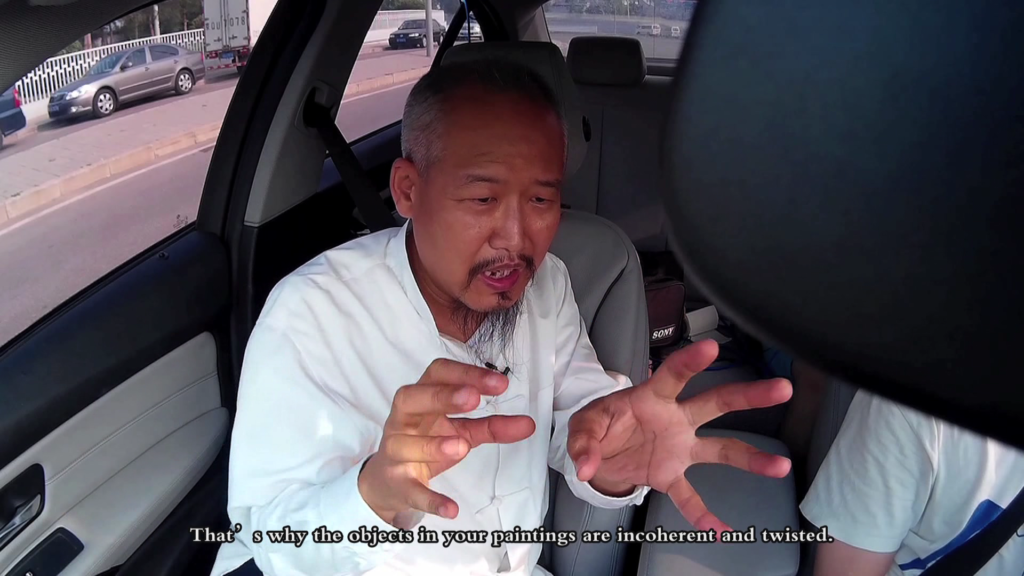Presenting:
The Great Metaphorist – Life is the Tenor, and Divination is the Vehicle
Single-channel digital HD video, color, sound, 35’21”, 2014
In the occasion of the screening, we are so honored to have invited artist Li Shurui to contribute an article about her analysis of this artwork.
text/Li Shurui
The Great Metaphorist
My studio has sat next to Guo Hongwei’s for the last ten years. We’ve gotten to know each other very well, so I probably can’t claim objectivity, though I will try not to talk him up either; instead I aim for a collected but flexible observer perspective.
This video has three chapters. The first shows Guo driving from his old home at Beiwei 40 (latitude 40 due north) to his studio in Heiqiao. As he drives from one familiar spot to another, he recites pre-written lines in a state somewhere between speech-making and mumbling, as though trying to sort through all the daily minutia that crosses his mind. The second chapter features Guo driving Master Baotong, a fengshui and fortune telling expert, from Heiqiao to his new home in Shunyi by way of airport express. They carry out an aimless conversation with no perceived purpose, which Master Baotong tries hard to discern, as they discuss such subjects as “premonition” and collecting and filtering information in an effort to formulate a systematic view of the world that leads to eventual life success. Guo is out of the frame throughout the chapter, asking questions from behind the camera. The third chapter features rappers Xiao Laohu (little tiger) and Dawei (David) sitting in the back seat of the car. Guo drives them from Heiqiao to Shunyi over a different route, asking the two performers to improvise and rap based on the things they see along the way. Over the 40 minute ride, the two rappers give inspirational performances but are also exhausted by the effort. It’s raining outside, and the two men are shuttered inside an enclosed space, pushing the boundaries of their creativity with an uncertain time constraint. Guo is completely hidden in this chapter, silently navigating the roads, rhythmically accelerating, merging, and passing according to the rappers’ pace.
The three chapters all feature “performers” who use their voice as a medium; their speech and performances are raw input for the viewer to process and filter according to their own experiences and expectations. The common thread that runs through the interpretation is “metaphors”. Metaphors have two ends – material goes in, result comes out, and the process in between is up to the person making the metaphor. Those who are more empathetic and convincing will act as spokesperson for the events being fed into the metaphor, and they’ll be approximating the ultimate truth about this chaotic universe we live in. To induce new concepts out of events and their projections are but a means of self-entertainment.
Guo, a self-made metaphorist, is a painter by trade. In his 2014 solo exhibit
The Great Metaphorist, he temporarily put down his indulgence in painting and took up a different art form in a parallel space-time, making use of otherwise mundane daily experiences such as his daily commute to create art. In this project, Guo extricates himself and thrusts minute but obsessive experiences and ideas into the viewers’ faces, forcing them to observe him from an up close and personal perspective, rather than through the veil of his fine brushstroke. In the end, Guo couldn’t avoid the paintbrush after all, having painted the covers of several fake books, which link together his different roles across the aforementioned parallel space-times. The exhibit serves no more purpose than to put his obsessions at peace. Hope you will enjoy the show.
About Guo Hongwei
Guo Hongwei, currently lives and works in Beijing. His art practice mainly focuses on oil painting, as well as collage, photography, and video. From 2011 to 2016, he established independent art space “Gland”.
About Li Shurui
The dynamics and movement of light and color have always been at the core of Li Shurui’s artistic expression. Li believes that the use of light and space in different cultures and times can effectively reflect the needs, desires and spiritual conditions of individuals. In recent years Li Shurui has developed an evermore comprehensive method of applications for her color configuration system. Starting from her own experience, Li explores the limits of painting, the idea and reality of formalism, and its functionality.
Li Shurui (b. 1981, Chongqing) received her BFA at Sichuan Fine Arts Institute (SFAI) in 2004. Li was granted 2016 New York Fellowship Program of Asian Cultural Council (ACC). Publications: Vitamin P2: New Perspectives in Painting, Phaidon Editors, Phaidon Press Limited, 2011; Younger than Jesus: Artist Directory, Editor: Massimiliano Gioni/Laura Hoptman/Lauren Cornell, Phaidon Press Limited, 2009; Recent exhibitions include LSR • TENDEREST AFFECTION, New Galerie, Pairs, France (2018); Light Extracts, SALTPROJECTS, Beijing, China (2018); A World in a Grain of Sand : Mapping Shapes and Sites for Social Deometries, Atlantis, Sanya, China (2018); Nine Journeys Through Time, Palazzo Reale, Milan, Italy (2018); SPIRAL STAIRS, AIKE, Shanghai, China (2018) ; NOW:A Dialogue on Female Chinese Contemporary Artists, Centre for Chinese Contemporary Art, Manchester, UK (2018); LSR • Deep White, WHITE SPACE BEIJING, Beijing, China (2017); Constellation, Georgian National Museum Dimitri Shevardnadze National Gallery, Tbilisi, Georgia (2017); No Man’s Land: Women Artists from the Rubell Family Collection, National Museum of Women in the Arts, Washington D.C., USA (2016); Turning Point: Contemporary Art in China Since 2000, Minsheng Art Museum, Shanghai, China (2016); No Longer / Not Yet, Minsheng Art Museum, Shanghai, China (2015); Jing Shen: The Act of Painting in Contemporary China, Padiglione d’Arte Contemporanea (PAC), Milan, Italy (2015); 28 Chinese, Asian Art Museum, San Francisco, USA (2015); About Painting, OCT Contemporary Art Terminal (OCAT), Xi’An, China (2014); ON|OFF, Ullens Center for Contemporary Art, Beijing, China (2013). Li Shurui currently lives and works in Beijing and Dali.


